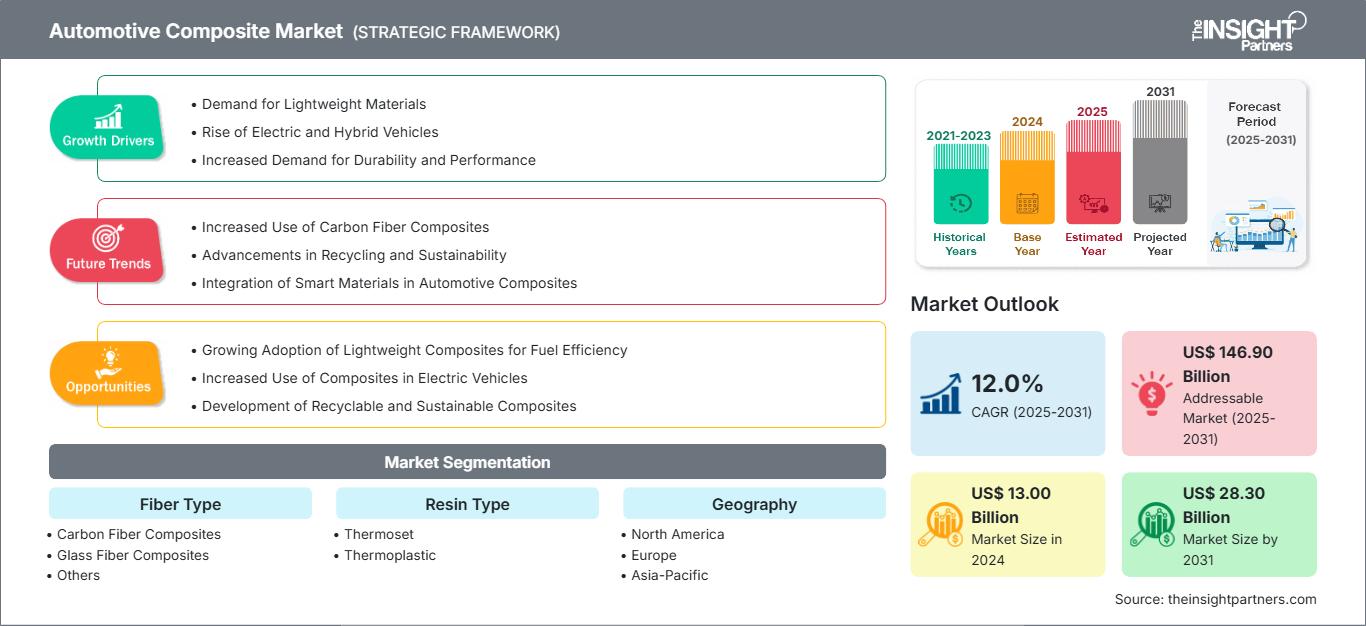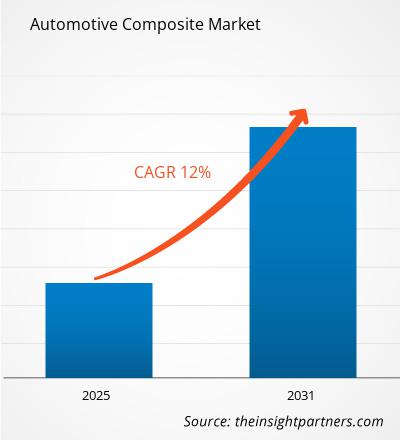Si prevede che il mercato dei compositi per l'automotive raggiungerà i 28,30 miliardi di dollari entro il 2031, rispetto ai 13,00 miliardi di dollari del 2024. Si stima che il mercato registrerà un CAGR del 12,0% durante il periodo di previsione.
Il rapporto è segmentato per tipo di fibra (compositi in fibra di carbonio, compositi in fibra di vetro e altri). Il rapporto presenta inoltre un'analisi basata sul tipo di resina [termoindurente (poliestere, vinilestere, epossidica, poliuretano e altri), termoplastica (polipropilene, polietilene, polivinilcloruro, polistirene, polietilene tereftalato, policarbonato e altri)]. In base al tipo di veicolo, il rapporto è segmentato in (veicoli passeggeri, veicoli commerciali leggeri (LCV), veicoli commerciali pesanti e veicoli a due ruote e altri). L'analisi globale è ulteriormente suddivisa a livello regionale e per i principali paesi. Il rapporto offre il valore in USD per l'analisi e i segmenti sopra indicati.
Scopo del rapporto
Il rapporto Automotive Composite Market di The Insight Partners mira a descrivere il panorama attuale e la crescita futura, i principali fattori trainanti, le sfide e le opportunità. Ciò fornirà approfondimenti a vari stakeholder aziendali, come:
- Fornitori/produttori di tecnologia: per comprendere le dinamiche di mercato in evoluzione e conoscere le potenziali opportunità di crescita, consentendo loro di prendere decisioni strategiche informate.
- Investitori: per condurre un'analisi completa delle tendenze in merito al tasso di crescita del mercato, alle proiezioni finanziarie di mercato e alle opportunità esistenti lungo la catena del valore.
- Organismi di regolamentazione: per regolamentare le politiche e le attività di polizia nel mercato con l'obiettivo di ridurre al minimo gli abusi, preservare la fiducia degli investitori e sostenere l'integrità e la stabilità del mercato.
Segmentazione del mercato dei compositi per autoveicoli Tipo di fibra
- Compositi in fibra di carbonio
- Compositi in fibra di vetro
- Altri
Tipo di resina
- Termoindurente
- Termoplastico
Potrai personalizzare gratuitamente qualsiasi rapporto, comprese parti di questo rapporto, o analisi a livello di paese, pacchetto dati Excel, oltre a usufruire di grandi offerte e sconti per start-up e università
Mercato dei compositi per l'automotive: Approfondimenti strategici

- Ottieni le principali tendenze chiave del mercato di questo rapporto.Questo campione GRATUITO includerà l'analisi dei dati, che vanno dalle tendenze di mercato alle stime e alle previsioni.
Fattori di crescita del mercato dei materiali compositi per l'industria automobilistica
- Domanda di materiali leggeri: l'industria automobilistica è sempre più concentrata sulla riduzione del peso dei veicoli per migliorare l'efficienza del carburante e ridurre le emissioni. I materiali compositi per l'industria automobilistica, come le plastiche rinforzate con fibra di carbonio e i compositi in fibra di vetro, offrono soluzioni leggere senza compromettere resistenza e durata. Il loro utilizzo in pannelli della carrozzeria, telai e interni è in rapida accelerazione.
- Ascesa dei veicoli elettrici e ibridi: la crescente popolarità dei veicoli elettrici (EV) e dei veicoli ibridi, che richiedono materiali leggeri per massimizzare le prestazioni e l'autonomia della batteria, sta alimentando la domanda di materiali compositi per l'industria automobilistica. Questi materiali contribuiscono a migliorare l'efficienza energetica complessiva, offrendo un rapporto resistenza/peso migliorato.
- Maggiore domanda di durata e prestazioni: i materiali compositi per l'industria automobilistica sono noti per la loro durata, resistenza alla corrosione e capacità di resistere a condizioni ambientali difficili. Con l'avanzare della tecnologia dei veicoli, la necessità di materiali che offrano elevate prestazioni pur essendo leggeri, resistenti alla corrosione e convenienti continua a crescere.
Tendenze future del mercato dei compositi per autoveicoli
- Crescente utilizzo di compositi in fibra di carbonio: poiché le case automobilistiche si concentrano sul miglioramento dell'efficienza nei consumi e sulla riduzione del peso dei veicoli, si prevede che i compositi in fibra di carbonio diventeranno più diffusi. Questi materiali offrono un significativo rapporto resistenza/peso, migliorando le prestazioni e l'efficienza energetica dei veicoli, in particolare nei veicoli elettrici, nelle auto di lusso e nei veicoli sportivi ad alte prestazioni.
- Progressi nel riciclaggio e nella sostenibilità: il futuro dei compositi per autoveicoli vedrà un'attenzione particolare al miglioramento della riciclabilità dei materiali compositi. Lo sviluppo di materiali compositi più facili da riciclare e più sostenibili stimolerà la crescita del settore automobilistico, poiché le preoccupazioni ambientali e la riduzione dei rifiuti diventano sempre più critiche.
- Integrazione di materiali intelligenti nei compositi per l'automotive: si prevede che l'ascesa dei compositi intelligenti con proprietà autoriparanti, sensori e altre funzionalità integrate rivoluzionerà l'industria automobilistica. Questi materiali consentiranno ai veicoli di monitorare le proprie condizioni, riparare piccoli danni e migliorarne le prestazioni complessive, con conseguente maggiore durata e riduzione dei costi di manutenzione.
Opportunità di mercato per i compositi per l'automotive
- Crescente adozione di compositi leggeri per l'efficienza dei consumi: poiché le case automobilistiche si concentrano sul miglioramento dell'efficienza dei consumi, i compositi leggeri, come la fibra di carbonio e la fibra di vetro, rappresentano un'importante opportunità di mercato. Questi materiali vengono integrati in parti della carrozzeria, telai e componenti interni dei veicoli per ridurre il peso, migliorare le prestazioni e soddisfare gli obiettivi normativi sulle emissioni.
- Maggiore utilizzo di materiali compositi nei veicoli elettrici: il passaggio ai veicoli elettrici (EV) offre significative opportunità per il mercato dei materiali compositi per l'industria automobilistica. I veicoli elettrici richiedono materiali leggeri per massimizzare l'autonomia e l'efficienza delle batterie, e i materiali compositi sono ideali a questo scopo. Con l'aumento della produzione di veicoli elettrici, aumenterà anche la domanda di materiali compositi avanzati in settori come gli alloggiamenti delle batterie, i componenti strutturali e gli elementi interni.
- Sviluppo di materiali compositi riciclabili e sostenibili: con la crescente attenzione alla sostenibilità, si sta sviluppando un mercato per i materiali compositi riciclabili ed ecocompatibili per l'industria automobilistica. I produttori stanno innovando con materiali compositi di origine biologica e riciclabili, in grado di soddisfare sia i requisiti prestazionali che quelli ambientali, rappresentando un'opportunità redditizia nel settore automobilistico ecologico.
Approfondimenti regionali sul mercato dei materiali compositi per l'automotive
Le tendenze regionali e i fattori che influenzano il mercato dei materiali compositi per l'automotive durante il periodo di previsione sono stati ampiamente spiegati dagli analisti di The Insight Partners. Questa sezione illustra anche i segmenti e la geografia del mercato dei materiali compositi per l'automotive in Nord America, Europa, Asia-Pacifico, Medio Oriente e Africa, America meridionale e centrale.
Ambito del rapporto sul mercato dei materiali compositi per autoveicoli
| Attributo del rapporto | Dettagli |
|---|---|
| Dimensioni del mercato in 2024 | US$ 13.00 Billion |
| Dimensioni del mercato per 2031 | US$ 28.30 Billion |
| CAGR globale (2025 - 2031) | 12.0% |
| Dati storici | 2021-2023 |
| Periodo di previsione | 2025-2031 |
| Segmenti coperti |
By Tipo di fibra
|
| Regioni e paesi coperti | Nord America
|
| Leader di mercato e profili aziendali chiave |
|
Densità degli attori del mercato dei materiali compositi per l'automotive: comprendere il suo impatto sulle dinamiche aziendali
Il mercato dei materiali compositi per l'automotive è in rapida crescita, trainato dalla crescente domanda degli utenti finali, dovuta a fattori quali l'evoluzione delle preferenze dei consumatori, i progressi tecnologici e una maggiore consapevolezza dei vantaggi del prodotto. Con l'aumento della domanda, le aziende stanno ampliando la propria offerta, innovando per soddisfare le esigenze dei consumatori e sfruttando le tendenze emergenti, alimentando ulteriormente la crescita del mercato.

- Ottieni il Mercato dei compositi per l'automotive Panoramica dei principali attori chiave
Punti di forza
- Copertura completa: il rapporto analizza in modo esaustivo prodotti, servizi, tipologie e utenti finali del mercato dei materiali compositi per autoveicoli, offrendo una panoramica olistica.
- Analisi degli esperti: il rapporto è redatto sulla base della profonda conoscenza di esperti e analisti del settore.
- Informazioni aggiornate: il rapporto garantisce la pertinenza aziendale grazie alla copertura di informazioni e tendenze dei dati più recenti.
- Opzioni di personalizzazione: questo rapporto può essere personalizzato per soddisfare le esigenze specifiche del cliente e adattarsi in modo appropriato alle strategie aziendali.
Il rapporto di ricerca sul mercato dei materiali compositi per autoveicoli può quindi contribuire a guidare il percorso di decodificazione e comprensione dello scenario del settore e delle prospettive di crescita. Sebbene possano esserci alcune valide preoccupazioni, i vantaggi complessivi di questo rapporto tendono a superare gli svantaggi.
- Analisi storica (2 anni), anno base, previsione (7 anni) con CAGR
- Analisi PEST e SWOT
- Valore/volume delle dimensioni del mercato - Globale, Regionale, Nazionale
- Industria e panorama competitivo
- Set di dati Excel
Report recenti
Testimonianze
Motivo dell'acquisto
- Processo decisionale informato
- Comprensione delle dinamiche di mercato
- Analisi competitiva
- Analisi dei clienti
- Previsioni di mercato
- Mitigazione del rischio
- Pianificazione strategica
- Giustificazione degli investimenti
- Identificazione dei mercati emergenti
- Miglioramento delle strategie di marketing
- Aumento dell'efficienza operativa
- Allineamento alle tendenze normative




















 Ottieni un campione gratuito per - Mercato dei compositi per l'automotive
Ottieni un campione gratuito per - Mercato dei compositi per l'automotive